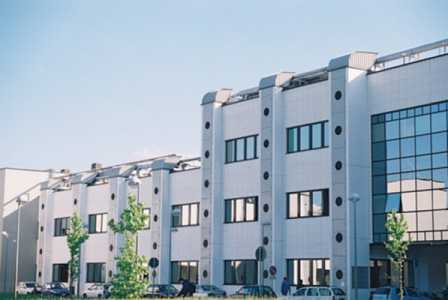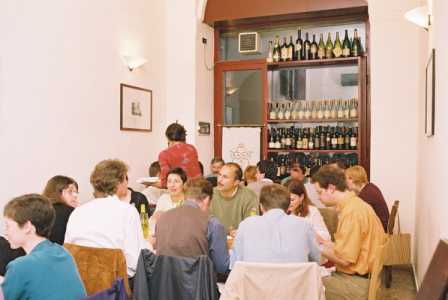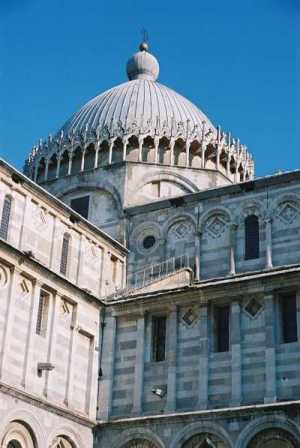Open Archive Forum Workshop: Creating a European Forum on Open Archives
Pisa is small medieval Italian town, and, as is well-known, it features some extraordinary architecture, both religious and secular, some of which dates back to the Roman period. The Square of Miracles is in a class by itself, but there are several notable buildings as you move towards the river Arno. Including the Scuola Normale Superiore, where Enrico Fermi studied, a medieval building refaced by the artist and art historian Vasari much later. It also features some interesting modern architecture, of which the CNR is a fine example. It first hoves into view as you arrive (by taxi) at a very Italian roundabout, almost entirely surrounded by advertising hoardings. And behind it, filling nearly half of your field of view, is the CNR. The entrance is a little further on, and non-descript: a narrow road which looks like it might have been once a railway line. Possibly the CNR was built on land formerly occupied by a marshalling yard. But it is a truly awesome sight: if it had existed in 1964 Antonioni might have chosen the building to appear in his film 'Red Desert'. No steam comes out of the featured ventilation ducts all around the roof, but that would have been the only necessary addition. The corridors seem endless.
The conference centre on the other hand is relatively easy to find, and (happily) the taxi drivers all seem to know where it is. Here a cross-section of implementers and interested parties gathered on the morning of the 13th of May 2002, to discuss Open Archives related issues in a European context.
The Conference
Donatella Castelli, one of the Forum's project partners, introduced the event, and Leona Carpenter of UKOLN gave an overview of the aims of the Forum. After this, there was an important presentation by Michael Nelson of the Open Archives Initiative, in which he reviewed the principal changes about to appear in the latest version (2.0) of the OAI Protocol for Metadata Harvesting. These changes include the use of six verbs (Identify List Metadataformats, List sets, List Identifiers, List Records, and Get Records) plus Dublin Core metadata, a single XML schema, the removal of some ambiguities, the addition of more expressive options, and a clearer separation of roles and responsibilities for data and service providers. This was the good news. The bad news was that version 2.0 is not backwards compatible with version 1.1. In version 1.1 the focus was on 'document-like objects'. This has now softened to a focus on 'resources'. He then went through the significant changes point by point.
Castelli closed the morning event with an Overview of Open Archives activity in Europe, considering each country in turn. This revealed an interesting range of work under way.
After lunch there were two breakout sessions which were run in parallel. One was on organisational issues: lessons we can learn from early adopters? Issues related to subject-based archives as opposed to institutional-based archives? Is simple Dublin Core metadata adequate? Which other formats might be used? How different are metadata requirements for different communities? Is cross-community interoperability desirable? The partitioning of archives? Do we need an e-prints application profile?; the other was on Terminology, which was based on a review of the OA-Forum glossary. Questions included: Are definitions clear? Are definitions correct? Do some terms also need to be defined in additional contexts? What terms are missing? What are their definitions?
The breakouts were followed by coffee, an then the report back by the rapporteurs.
After the reporting session there were two further presentations. The first of these was by Martin Vesely who spoke about the Document Server software used by CERN. Following this was a presentation by Steve Hitchcock of the University of Southampton, where there is a large and enthusiastic community involved with the Open Archives and the e-prints idea. The Hitchcock paper was titled 'Revealing a new dynamic: interaction in Open Access Archives' and was summary of Stevan Harnad's view that e-prints and the self-archiving process are a way of freeing refereed literature from the clutches of academic serials publishers.
Afterwards there was an excellent official dinner in a restaurant in the centre of the town (Osteria Dei Cavalieri in S. Frediano street), not far from the Scuola Normale, where we were reminded of Pisa's history as a maritime power by the fact that four of the five superb courses featured different sea foods.
Day two opened with a presentation by Francoise Genova of CDS on the importance of On-line information in Astronomy, subtitled 'from networking to virtual observatory'. Astronomers were quick to take advantage of the Internet, since they are a relatively small and highly distributed community. They often have to be miles from anywhere to take advantage of local climatic conditions, and benefit hugely from the capacity to access remote data. Genova made this clear, and illustrated the role for OAI metadata. This was followed by Fabio Asnicar (International School for Advanced Studies) whose subject was the Open Portal 'Torii'. The final presentation of the morning was by Umberto Straccia of the IEI-CNR, the hosts for the event. The subject was the Cyclades project (pronounced 'kikla-dees'. Apparently it isn't an acronym for anything). The project's aim is the development of an open collaborative virtual archive environment.
After lunch there were another two breakout sessions in parallel. The first of these was on 'Communities and Services'. Questions included: 'What communities can benefit from the open archive approach? Which type of services become possible? Is the Open Archives Initiative Protocol for Metadata Harvesting powerful enough to support the services required by the e-print community? Is OAI-PMH only a component of a richer set of tools required for supporting open archives? What lessons have been learned by early adopters in the context of service provision? The second session was titled 'Technical Validation/Software. Questions included: What kind of software tools are needed to support the open archives approach? What tools are already being used? Who is developing them? In Europe, Elsewhere? Are they available to other implementers? Is there an appropriate 'Open Source' environment for these tools?
We broke for lunch, and reconvened at 2pm to hear the reporting back from the breakout sessions.
Finally, Leona Carpenter provided a summing-up of the main issues which were facing the community, and outlined the road forward for the OA-Forum.
Author Details
| Ariadne, UKOLN, University of Bath E-mail: ariadne@ukoln.ac.uk |



